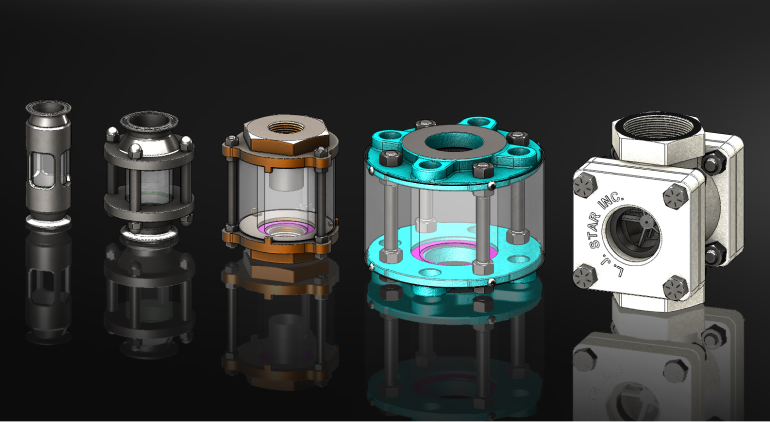In hydraulic pipelines flow indicators refer to observation of fluid movement through the piping system. This is critical in oil and gas, paper and pulp, water distribution, and chemical processing industries.

Visual observation and Machine vision flow indicators serve the same purpose in two different ways. A human eye has 6 million cone photo receptors and 120 million rod cells in its retina (Ref.: Vision Center). No machine sensor equals this level of sensitivity and direct processing of information. Main purpose of a flow indicator is to inform the person observing the process flow, either directly by looking through the glass, or remotely by monitoring a signal from a remote device installed in a pipe.
Speaking of direct visual observations, visual flow indicators come in four different types, or styles, such as: plain view, rotary type, drip tube and paddle type.
Plain view flow indicators have oppositely placed windows with the flow going in-between them. The fluid flow is admitted into the flow indicator using piping connections such as NPT male or female. Flanged connections such as ASME or DIN are also common in flow indicators. A subset of plain view flow indicators are the types with a 360-degree full view, where a transparent section between the inlet and outlet flanges is installed. This is a preferred visual observation method in low pressure systems. The inlet and outlet flanges are precisely spaced by reenforcing rods, with the transparent element free of compressive stresses.
Rotator type, or rotameter flow indicator is a similar to a plain view one with one addition: a small wheel is placed inside the flow cavity, offset from the flow axis. This allows for rotation motion of the wheel, (impeller or a rotor). The benefit of a rotator type flow indicator is better indication of flow of transparent fluids. Naked eye cannot detect flow of clear liquids or gasses, especially when the flow is laminar undisturbed by turbulence. Rotators spin, a person can see that indicating presence of flow. This is simply a qualitative assessment if the fluid is or is not moving through the pipe. For quick on-off visual observation a rotator type flow indicator is a preferred choice with water, clear liquids, and clear gas piping systems.
Drip-Tube type visual flow indicator has the same form as the plain view type, with an addition of a tube inserted in the flow cavity. The purpose of the tube is to concentrate the flow in the center of the device. Drip tube style indicators are installed vertically.
Paddle style flow indicators have a paddle in the flow path to distribute low flow rate across the edge of the paddle. Also known as flapper flow indicators, these can be installed horizontally or vertically in piping lines.
A subset of visual flow indicators is for sanitary applications. Sanitary or Hygienic flow indicators are void of any crevices to trap bacteria. The internals are designed with smooth transitions between adjacent components and no gaps. These are manufactured to 3-A 28-06 standard establishing the criteria for surface finishes, materials and design of equipment used in food, dairy processing. Typical materials of construction in sanitary flow indicators are 304 stainless steel, sapphire or borosilicate, and fluoroelastomer chemical-resistant gaskets. In special cases the internals are lined with an oxide or nitride compound hard coating.
A reliable and a simple method for visual flow observation is a sight glass, a translucent window installed directly into the pipeline. Operators can visually inspect the fluid level and flow, by looking through the sight glass. This is common in pipelines where the fluid is visible providing a direct, real-time view of the flow.
For quantitative volumetric or mass flow measurement, there are electromagnetic flow meters, ultrasonic flow meters, vortex flow meters, and differential pressure flow meters. The choice of the flow measurement instrument depends on the type of fluid, fluid density, viscosity, pressure, operating temperature, pipe size and the level of accuracy required.